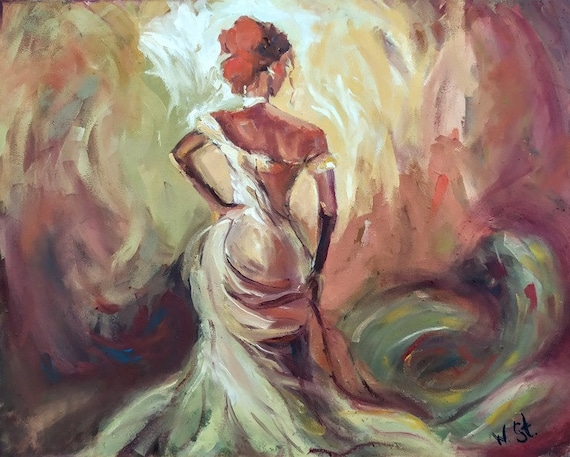The Evolution of Art: A Comprehensive Guide to Figurative Oil Painting
The Evolution of Art: A Comprehensive Guide to Figurative Oil Painting
Blog Article
The Duty of Feeling and Expression in Metaphorical Oil Paint: A Comprehensive Evaluation of Subject and Make-up
The interplay of feeling and expression in metaphorical oil paint serves as a vital lens through which one can check out the elaborate relationship between subject issue and structure. Artists harness different strategies, from shade choice to brushstroke characteristics, to cultivate psychological vibration within their jobs.
Comprehending Emotion in Art
Emotion in art works as an effective conduit for expression, permitting artists to convey intricate sensations through their work. In metaphorical oil painting, this emotional deepness is usually depicted via the representation of the human number, recording the subtleties of human experience. The selection of topic, color combination, and brushwork all contribute to the emotional vibration of an item.
Artists often attract upon individual experiences, societal concerns, or global styles to stimulate sensations in the visitor. For instance, a picture might reflect vulnerability, while a dynamic number in motion can represent liberty or chaos. These psychological strings attach the customer to the artwork, promoting a dialogue that transcends the visual tool.
Moreover, the interaction between light and shadow can intensify emotional intensity, guiding the customer's gaze and accentuating particular components within the composition. Using texture in oil painting even more includes layers of intricacy, inviting a tactile feedback that improves the emotional experience. On the whole, understanding feeling in art is important for valuing the subtleties that characterize figurative oil painting, as it changes plain depiction into a profound exploration of the human problem.
Secret Aspects of Make-up
In the world of metaphorical oil painting, the make-up works as the underlying framework that arranges aesthetic elements and improves the psychological narrative. Important parts of structure consist of equilibrium, comparison, centerpiece, and rhythm, each adding to the overall effect of the art work.
Equilibrium describes the circulation of visual weight within the painting, which can be achieved with balanced or unbalanced setups. A healthy make-up offers security, enabling the visitor to engage with the piece sympathetically - figurative oil painting. Comparison, on the other hand, includes juxtaposing different elements, such as light and dark or warm and awesome shades, to lead the visitor's eye and evoke emotional responses
The centerpiece is essential, as it routes attention to the most significant part of the paint, often highlighting the psychological core of the story. Via techniques like shade saturation or placement, musicians can highlight this location properly. Finally, rhythm relate to the rep of components, producing a feeling of activity and circulation throughout the make-up. By masterfully incorporating these key aspects, musicians can craft psychologically powerful and compelling figurative oil paints that captivate and involve their target market.
Subject and Its Effect
Subject plays a pivotal role in figurative oil painting, as it not only functions as the structure for the story however likewise forms the audience's interpretation and emotional interaction with the artwork. The option of subject-- be it a singular figure, a group dynamic, or a thematic representation-- straight influences the emotional atmosphere communicated to the target market.

For circumstances, portraits usually stimulate individual links, exposing the complexities of human expression and personality, while scenes illustrating common tasks can produce a sense of belonging or fond memories. Moreover, the cultural and historic context of the subject issue improves the visitor's understanding, motivating much deeper representations on social standards, worths, and the human problem.
Various subjects likewise create varying levels of involvement; a remarkable problem official source depicted via figures in stress might elicit feelings of stress and anxiety or empathy, while tranquil landscapes can conjure up tranquility and consideration. Ultimately, the influence of subject matter in figurative oil painting is profound, as it offers as an avenue for emotional resonance, assisting the customer's reaction and interpretation, and promoting a connection in between the onlooker and the art work. This interaction is important for the successful interaction of the musician's intent.
Strategies for Stimulating Sensations
The performance of figurative oil painting in conveying emotions is significantly affected by the techniques used by the musician. Among one of the most important techniques is making use of shade concept, where the tactical choice of shades can evoke certain emotional feedbacks. Cozy shades, such as oranges and reds, often evoke feelings of passion or aggression, while cooler tones like blues and greens tend to stimulate peace or despair.
An additional crucial strategy is the manipulation of light and darkness, referred to as chiaroscuro. This approach improves the three-dimensionality of numbers, developing dramatic contrasts that can escalate psychological depth. The placement of light can assist audiences' emotions, highlighting specific components of the make-up.
Brushwork likewise plays a vital function; loose, meaningful strokes can share power and spontaneity, whereas smoother methods might recommend tranquility or precision. The arrangement of topics within the structure can affect psychological effect. Close proximity can recommend intimacy, while distance may indicate isolation.
Ultimately, the combination of these techniques makes it possible for musicians to craft narratives that resonate with the visitor, changing a plain aesthetic experience into an evocative psychological journey. - figurative oil painting

Study of Noteworthy Works
Checking out notable jobs of figurative oil painting discloses exactly how numerous techniques are employed to evoke effective emotions. One exemplary situation is Edvard Munch's "The Scream," where the altered figure and swirling history convey existential dread. Munch's use shade-- vivid oranges and deep blues-- escalates the emotional impact, showcasing exactly how scheme selections can shape audience experience.
One more considerable work is Pablo Picasso's "Les Demoiselles d'Avignon." Right here, fragmented types and strong brushstrokes mirror a turbulent emotional landscape, testing traditional representations of the female number. Picasso's ingenious structure not only captures the audience's focus however likewise invites contemplation on themes of identity and sexuality.
Furthermore, Frida Kahlo's "The Two Fridas" provides a poignant expedition of duality and self-identity. The different numbers, connected by a shared heart, exemplify Kahlo's psychological deepness and personal narrative. figurative oil painting. Her precise interest to information and symbolic components offer to involve customers on a visceral degree
These study emphasize the profound link in between feeling and make-up in metaphorical oil paint, exposing how artists harness strategy to communicate intricate feelings and stories that reverberate across time and culture.

Conclusion
To conclude, the interplay of feeling and expression in figurative oil paint considerably boosts the audience's experience and analysis of the artwork. With a mindful selection of subject and compositional techniques, artists share profound narratives that reverberate on both personal and global degrees. go to the website The application of shade chiaroscuro, brushwork, and concept additional magnifies psychological depth, transforming each canvas right into a powerful representation of the complexities of the human experience.
In figurative oil painting, this psychological deepness is often depicted via the depiction of the human figure, catching the subtleties of human experience.Moreover, the interaction in between light and shadow can enhance psychological strength, leading the viewer's look and attracting focus to specific aspects within the make-up. The usage of appearance in oil paint even more includes layers of intricacy, welcoming a responsive feedback that enhances the emotional experience.The focal point is crucial, as it directs attention to the most considerable view website part of the paint, usually highlighting the emotional core of the narrative. Ultimately, the impact of subject matter in metaphorical oil paint is profound, as it serves as a channel for emotional resonance, directing the audience's response and analysis, and fostering a connection in between the viewer and the art work.
Report this page